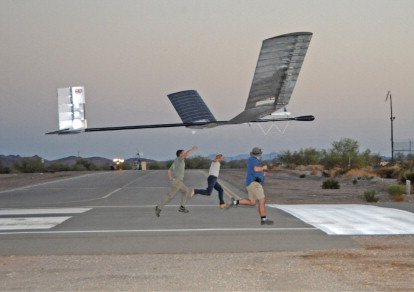
The high-altitude long-endurance (HALE) Zephyr aircraft from QinetiQ of Hampshire, UK, flew for 82 hours and 37 minutes. This unofficially exceeds the current official world record for unmanned flight which stands at 30 hours 24 minutes set by Global Hawk in 2001, and Zephyr's previous longest flight of 54 hours achieved last year.
The 30 kg carbon-fibre aircraft flies on solar power generated by amorphous silicon solar arrays covering the aircraft's 18 m wingspan. At night, it is powered by rechargeable lithium-sulphur batteries supplied by SION Power Inc of Tucson, Arizona, which are charged by the solar cells at day. Zephyr is hand-launched by three people running for about 30 yards (27 m).
QinetiQ could not comment on the production methods used for the aircraft or give component details.
The flight trial, which took place at the US Army's Yuma Proving Ground in the Sonoran Desert in Arizona, was held in temperatures up to 45°C. The Zephyr was flown on autopilot and via satellite communications to a maximum altitude of more than 60 000 ft with temperatures dropping below -50°C.
The unmanned solar aircraft can be employed for earth observation and communications relays in support of a range of defence, security and civil requirements.
The development to date has been funded by the UK Ministry of Defence partnered with the US Department of Defense (DoD) under their Joint Capability Technology Demonstration (JCTD) Programme, which is designed to move urgently needed technologies rapidly into the hands of the US forces in the field.






